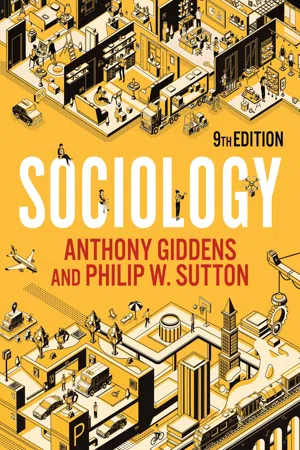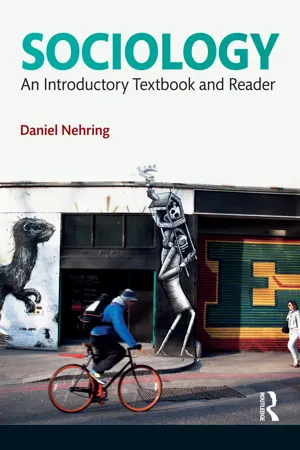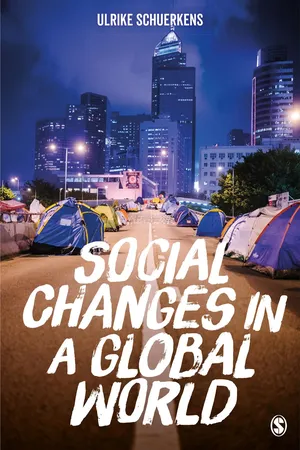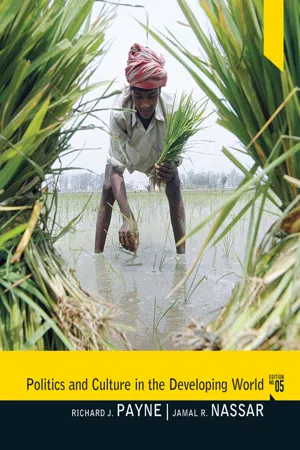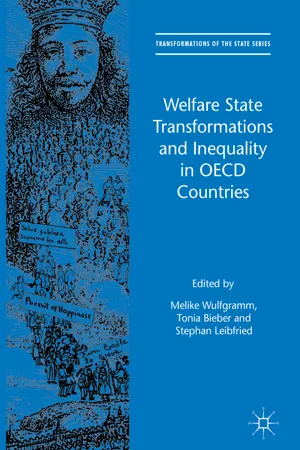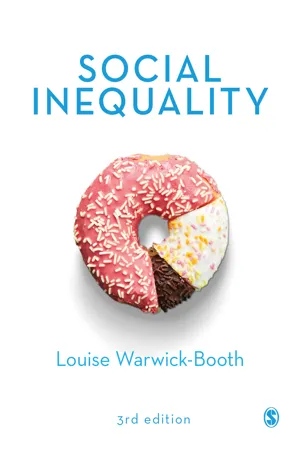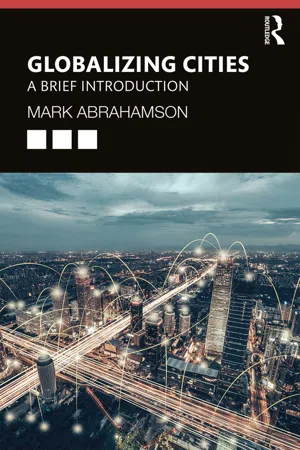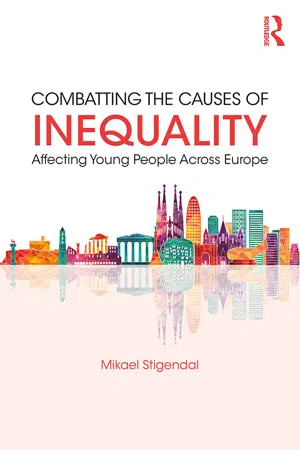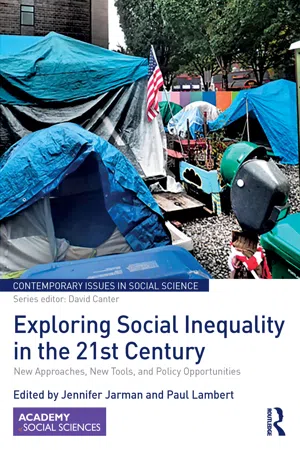Social Sciences
Global Inequality
Global inequality refers to the unequal distribution of resources, wealth, and opportunities among countries and individuals worldwide. It encompasses disparities in income, education, healthcare, and living standards, and is influenced by factors such as economic policies, trade agreements, and historical legacies. Addressing global inequality requires understanding its complex causes and implementing policies to promote greater equity and social justice on a global scale.
Written by Perlego with AI-assistance
Related key terms
11 Key excerpts on "Global Inequality"
- eBook - ePub
- Anthony Giddens, Philip W. Sutton(Authors)
- 2021(Publication Date)
- Polity(Publisher)
CONTENTS
- Extremes of inequality
- Global Inequality
- Discourses of Global Inequality
- Measuring economic inequality
- Inequality and human development
- Unequal life chances
- Health
- Hunger, malnutrition and famine
- Education, literacy and child labour
- The changing human population
- Population analysis: demography
- Dynamics of population change
- The demographic transition
- Development theories and their critics
- Theories of development
- Evaluating theories of development
- Development amid inequality
- Prospects for the twenty-first century
- Chapter review
- Research in practice
- Thinking it through
- Society in the arts
- Further reading
- Internet links
World wealth map 2018, average wealth per adult (in US$)Figure 6.1Source: Shorrocks et al. (2018: 7)C ould you be among the top 50 per cent of wealth holders in the world? If you had net assets of US$4,210 in 2018, then you were. Congratulations. Could your personal wealth place you within the richest 10 per cent of the global population? For that you would have needed net assets of US$93,170. If you live in a developed industrial country and own a property, there is a very good chance that you would meet that criterion. And if you had net assets of at least US$871,320 then you were one of the wealthiest 1 per cent of people on planet Earth.The study of social inequality is one of sociology’s foundational subjects. Nineteenth-century capitalist industrialization increased the wealth of societies but also brought into sharp relief the growing gap between the incomes and wealth of rich and poor. Inequality within particular nation-state societies remains a key concern for many sociologists today. Yet as globalization processes brought societies and people into closer contact with each other, the focus has shifted to take in inequalities between societies and individuals at the global level. The place where individuals are born – the ‘accident of birth’ – can have a major influence on their prospects of living a comfortable, financially secure life. - eBook - ePub
Sociology
An Introductory Textbook and Reader
- Daniel Nehring, Ken Plummer(Authors)
- 2014(Publication Date)
- Routledge(Publisher)
Now explain in your own words why you believe that the issue you have chosen is socially and sociologically significant. To do so, you need to look into it quite systematically. You might choose an international perspective, or you might consider any one particular place in the world. Look for academic publications, official reports, media coverage and other public documents. What are the patterns of inequality that have been reported regarding your chosen issue? What sociological concepts, if any, have been used to describe them? How are they being addressed? How are they related to other forms of social inequality? Write a report on your findings.6.6 Global inequalities and global poverty
So far, we have explored the ways in which societies are internally stratified. Race, class, gender, sexuality, age, disabilities and other characteristics differentiate individuals and social groups. Moreover, they establish hierarchies in terms of power, recognition by others, and access to the resources we need to live and live well. However, as we have already seen in previous chapters, it is not sufficient to look only at social inequalities within individual societies. Over the past centuries, a global social system has slowly taken shape, within which societies are closely tied together through the spread of fashions, values and beliefs, commerce, the production and consumption of goods, transnational friendships and marriages, warfare and imperial conquest, and so forth. Some scholars, such as Manuel Castells (2000 ) argue that we now live in one global network society. However, the very same forces that have tied societies together have also driven them apart, creating a tight web of inequity, exploitation and disparate life chances. Alongside debates about social inequalities within societies, it is necessary to look at the ways in which global social inequalities cut across borders in the contemporary world. The remainder of this chapter will consider questions surrounding these global inequalities.The Human Development Index (HDI) is one key indicator of global inequalities. Compiled by the United Nations Development Programme for its annual Human Development Reports, it uses indicators of health, education and living standards to measure and compare the overall quality of life in countries across the world. Countries are assigned values between ‘1’ (highest human development) and ‘0’ and ranked in four groups, from ‘very high human development’ to ‘low human development’. The HDI is meant to serve as a tool for the systematic improvement of the quality of life across the planet. However, it also points to global hierarchies and inequalities in terms of the life chances of people in different societies. In the 2011 HDI, Norway (with a human development value of 0.943), Australia (0.929), The Netherlands (0.910), the USA (0.910), and New Zealand (0.908) were firmly established at the top, while the Democratic Republic of the Congo (0.286), Niger (0.295), Burundi (0.316), Mozambique (0.322), and Chad (0.328) languish at the bottom (http://hdr.undp.org/en/media/HDR_2011_EN_Table1.pdf - eBook - ePub
- Ulrike Schuerkens(Author)
- 2017(Publication Date)
- SAGE Publications Ltd(Publisher)
4 Globalization and the Transformation of Social InequalitySummary
Social inequality is a worldwide phenomenon. Globalization has both exacerbated and alleviated inequality over the past 25 years. This chapter offers analytical and comparative insights from current case studies of social inequality within all the major regions of the world. The author provides an assessment of the overall social globalization phenomenon in the global world as well as an outlook of transformations of global social inequality in the future. This chapter contributes to our understanding of current transformations of social inequalities in different parts of the world and reveals regional, national, and local differences in inequality patterns and globalization impacts and the importance of political choices for inequality levels.Introduction
In recent years, a number of publications have discussed the link between globalization and inequality (e.g. Wade, 2007; Milanovic, 2011b). So far, social inequality is measured within countries, between countries, and also globally among all populations of the world. Currently, a relative consensus seems to exist that insists on the fact that in-country inequality has increased almost everywhere over the past 20 years. International inequality has fallen since the late 1970s, when China and India were included (Held and Kaya, 2007: 5‒6); when these countries – which together have more than one fifth of the world’s population – are excluded, an increase in international income inequality can be found. Nevertheless, Global Inequality among nations, according to the Gini coefficient, is very high but decreasing: from 72 points in 1988 and 1993 to 70.5 points in 2008 or even 69 on a scale that goes to 100 for a more detailed sample (Held and Kaya, 2007: 5 and Milanovic, 2011b). The 2011 global Gini coefficient was 67, some 2 points lower than in 2008. This change has been driven by the high growth rates in China and India and for the last years by the absence of growth in Northern European countries and the USA. The USA mean income, for instance, was lower in 2011 than three years before. - eBook - ePub
- Richard J. Payne, Jamal R. Nassar(Authors)
- 2015(Publication Date)
- Routledge(Publisher)
CHAPTER 5Global and Domestic Inequalities
Globalization and Global and Domestic Inequalities
The global financial and economic crises of 2008 and 2009 increased attention to economic inequality in both rich and poor countries. Globalization, which encourages the growth of free trade, open markets, and competition in the world economy, is viewed as contributing to both equality and inequality among as well as within countries. Globalization offers opportunities to states and individuals. By making national borders less significant and more porous, globalization challenges the prevailing tendency to view the world almost exclusively in terms of rich nations versus poor nations. Economic inequalities among and within countries have always existed and cannot be attributed primarily to globalization. Global economic interdependence means that major economic problems spread from one country to another, thereby heightening the sense of economic insecurity as well as widening the gap between the rich and the poor. But globalization also holds the promise of greater opportunities for the poor to improve their economic positions. Countries that are more involved in the global economy tend to have less poverty and greater income equality.D iscussions about wealth and poverty are as old as humankind. Individuals, groups, and governments throughout the world have, at one time or another, wrestled with the issue of economic inequality and income distributions. Despite many efforts to narrow the gap between rich and poor individuals, groups, and countries, the adage that the rich get richer and the poor get children seems to be supported by continuing global and domestic inequalities. The fact that inequality exists is not in and of itself the major problem, especially if the standard of living for those on the bottom is improving. In a wealthy society, such as the United States, inequality is mitigated by access to social services, training, and education. Wide economic disparities are often narrowed in a growing economy and the possibility of upward mobility creates hope among the poor. However, financial and economic crises in 2008 and 2009 challenged this view. Extreme and relatively permanent economic inequality within as well as among countries is widely regarded as detrimental to political stability and economic development. Extreme inequality, especially in societies with a weak middle class, often leads to the concentration of social and political power and the stifling of competition. As Chapter 9 - Melike Wulfgramm, Tonia Bieber, Stephan Leibfried, Melike Wulfgramm, Tonia Bieber, Stephan Leibfried, Melike Wulfgramm, Tonia Bieber, Stephan Leibfried(Authors)
- 2017(Publication Date)
- Palgrave Macmillan(Publisher)
In particular, global accounts of gender inequality appear to be slightly more positive and optimistic. For example, gender differences in employment are shrinking in the OECD world, which leads to lower income inequalities on that account (OECD 2015c). However, there are still considerable differences in gender equality on the global level. As the UN (2015b : 13) reports, in almost all countries in Asia, for example, the participation of women in the labour market is below 40 per cent (compared to 75 per cent of men). 1 Given that inequalities based on age, gender and other factors do not often appear in isolation, an Overseas Development Institute (ODI) report has emphasized the problem of intersecting inequalities. With reference to Kabeer (2010), the notion of intersecting inequalities refers to ‘the “deep exclusion” of groups of people who suffer multiple forms of discrimination and disadvantage—and the need to tackle such intersecting inequalities in order to complete the job of eradicating absolute poverty’ (ODI 2014 : 1). Accordingly, the global discourse on inequalities is a broad and complex field made up of the illustrations, explanations and prescriptions of global social policy actors. Given that SDG10 addresses inequality, it is likely that the issue will continue to be subject to such reports. This prospect indicates a current emphasis in global discourse on placing issues of poverty in the context of a connected world and presenting data to show the comparative relationships between different places in the world. Income inequality is also often emphasized. Other and to some extent related debates concern gender inequalities, health inequalities and other inequalities related to particular groups. Global Social Policy Mechanisms Affecting Inequality Moral justifications and ideas are not the only concerns of national social policy-makers when addressing inequality. Global context, structures and conditions must also be considered- eBook - ePub
- Louise Warwick-Booth(Author)
- 2022(Publication Date)
- SAGE Publications Ltd(Publisher)
10 Globalisation and the Global Dimensions of InequalityKey learning outcomes
By the end of this chapter, you should be able to:- understand the concept of globalisation;
- understand the complex relationship between globalisation and social inequality;
- understand the different ideological positions associated with the concept of globalisation that are used to explain its impact.
Overview of the chapter
This chapter contextualises current understandings of inequality within a broader global context, showing that inequality cannot be understood without a global perspective. The chapter explores the key question of how globalisation has affected and altered inequality by discussing the concept of globalisation and exploring its relationship to inequality. It introduces competing opinions about whether globalisation is beneficial for creating a more equal society, as well as introducing discussions and evidence suggesting that it actually worsens inequality. The chapter addresses key questions such as how current global economic trends are affecting inequalities, and it discusses how the global impacts on the national in terms of social inequality.Defining globalisation
Globalisation has been defined in a number of ways within the academic literature, which shows that it has many components, such as social, cultural and economic aspects (Jacobsen 2014). While globalisation is an imprecise term, it is ultimately a process driven by technological change and advancements in communications, with the pace of such changes being very fast compared to previous historical eras (Giddens and Sutton 2021), despite global social change being nothing new. In brief, globalisation can be described as the increased social, economic and political interconnectedness of the world. - eBook - ePub
Globalizing Cities
A Brief Introduction
- Mark Abrahamson(Author)
- 2019(Publication Date)
- Routledge(Publisher)
3It is a very high degree of inequality in a city or nation that is associated with multiple and diverse social and political problems. In several large cities in Latin America, for example, studies have reported a correlation between the degree of inequality and the amount of kidnapping that occurs.4 Because the kidnappers are usually poor and their victims rich, the transfer of money in a ransom payment becomes, in effect, a Robin Hood way of redistributing income. Other analyses suggest that the greater the degree of income inequality in a nation, the greater the differences in how much overall satisfaction people express when they are asked how they feel about “their lives as a whole these days.”5 Some studies even contend that excessive inequality, as a by-product of globalization, reduces social solidarity and feelings of trust and produces political instability.6 Therefore, if extreme degrees of inequality are an essential feature of cities and nations in a globalized world, that may portend serious and widespread social problems.GLOBALIZATION AND WORLD CITIES
One of the most influential perspectives that both predicted increased inequality as a by-product of globalization and provided an explanation for that increase has come out of the Globalization and World Cities Research Network (GaWC) previously discussed in Chapter 2 . It can be helpful to introduce GaWC in relation to the perspective of world systems theory (WST). The latter contends that nations can be place into three categories—core, semi-periphery, and periphery—based upon the nature of their transnational connections. The more industrialized nations in the core are dominant and benefit from their place in the world economic order by maintaining exploitive relations with nations in the periphery, obtaining their labor (and raw materials) cheaply. As a result of this relationship, there is a global elite in the core nations that is highly skilled and very well paid and a large, unskilled and very poor class in the peripheral nations.7 - eBook - ePub
- Robert J. Holton(Author)
- 2014(Publication Date)
- Bloomsbury Academic(Publisher)
4Global Inequalities of Income and WealthThe most widely used approach to Global Inequality is based on evidence about income. It is statistics of income inequality that are most likely to be cited in public debates on economic development and social justice. Measures of the huge disparity between the richest and the poorest countries or between the top 1% of the world’s population and the rest typically cite statistics on income in support of the policy prescriptions that are favoured. Underlying this focus is the work of economists and sociologists on levels and trends in income inequality and how they are to be explained. In this first of two chapters on evidence of Global Inequality, I look in more depth at income and wealth, moving on in the following chapter to consider wider social measures of inequality.How far is it possible to make bold judgements about the scale and patterns of global income inequality in the contemporary setting? Is it rising or falling? Does it follow a consistent pattern and trend? And how reliable is the evidence base on which such judgements rest?In the first part of this chapter, the focus will be on general features of Global Inequality which command a high level of consensus among analysts. In the second part attention shifts to those issues about which there is more disagreement and uncertainty.Some Very General Features of Global Income InequalityIt is possible to make some bold judgements about global income inequality about which there is general agreement. The evidence on which these judgements rest is primarily quantitative in form, depending on statistical evidence collected or assembled in a variety of ways. Accurate data is sometimes difficult or impossible to locate, especially for poorer countries lacking the resources to collect adequate data (Jerven 2013). Also the assumptions used in statistical analysis also vary. I shall return to some of these methodological issues later. For the moment, attention is given to four propositions which sum up the general features about which there is most agreement. - eBook - ePub
The Millennium Development Goals
Raising the Resources to Tackle World Poverty
- Fantu Cheru, Colin Bradford Jr., Fantu Cheru, Colin Bradford Jr.(Authors)
- 2013(Publication Date)
- Zed Books(Publisher)
1
Global Inequality, Poverty and Justice: Empirical and Policy Issues
RAIMO VÄYRYNENThe relevance of inequality
Observations about degrees of trends in Global Inequality have both conceptual and empirical dimensions. In addition, these dimensions of inequality have political, institutional and normative aspects that obtain added significance through their links with the process of globalisation. In fact, inequality has become a major issue in the debates concerning globalisation and its effects on individuals, social groups, regions and nation states. The merits of globalisation are assessed, to a large degree, on the basis of whether it enhances or diminishes poverty and inequality.In effect, poverty and inequality have become major yardsticks of the legitimacy of the globalisation process. This is evident in the Millennium Declaration and the Millennium Development Goals (MDGs) enunciated by the UN General Assembly in 2000. A similar benchmark for the success of globalisation has been set up by the World Commission on the Social Dimension of Globalisation in its recent report.Our primary concerns are that globalisation should benefit all countries and should raise the welfare of all people throughout the world. This implies that it should raise the rate of economic growth in poor countries and reduce world poverty, and that it should not increase inequalities or undermine socio-economic security within countries. (WCSDG 2004 )The Commission accepts inequality as a fact of life, but is opposed to its increase as a result of the opening up of national markets.Most social theories consider equality as a necessary condition of the good life, or at least regard marked inequality as a hindrance to it. Obviously, in particular in liberal theory, equality is often confined to the political sphere, while the market system is expected to produce economic efficiency through some degree of inequality. In the past, social theories have focused primarily on the essential badness (but sometimes on the essential goodness) of inequality. Beitz (2001 - Mikael Stigendal(Author)
- 2018(Publication Date)
- Routledge(Publisher)
2What is inequality?
Inequality is “one of the most pressing issues of the day”, Michael Burawoy, president of the International Sociological Association, said in his welcome address to the World Congress of Sociology in 2014 with the title “Facing an unequal world”. The World Economic Forum, in its Global Risks Report 2017, ranks inequality first among the risks to the global economy and the underlying trends that will determine the shape of the world in the next decade.As the OECD Secretary General Angel Gurria wrote in his editorial to the report Divided we stand. Why inequality keeps rising (OECD, 2011: 17), “inequality has become a universal concern, among both policy makers and societies at large”. He then went on and mentioned the huge difference in incomes between the rich and poor. That is obviously an inequality, about which scholars like Anthony Atkinson, Branco Milanovic and Thomas Piketty (2014) have vastly expanded the empirical knowledge. Corresponding achievements have been made by epidemiologists like in particular Michael Marmot (2015) and Richard Wilkinson & Kate Picket (2009), focusing on inequality in terms of health (WHO, 2008). What have these inequalities in common? What makes them inequalities? What else is inequality? What should we mean by inequality?First of all, inequality is a word; in itself it also has certain properties. Something exists which we have decided to call inequality and the name of it puts us on a certain track to an understanding of it. Similarly, the word poverty tends to direct us, but more narrowly, to focus on the poor. There is nothing inevitable in the word ‘poverty’ which makes us become interested in the rich. To be sure, our wider perspective may certainly motivate such an interest, but the single word poverty does not. You need to be thoughtful and as Tawney described it thoughtfully in the early 20th century “what thoughtful rich people call the problem of poverty, thoughtful poor people call with equal justice a problem of riches” (from Sayer, 2015: 29). Indeed, this lack of interest in the problem of riches is confirmed by the major part of research which has occupied itself solely with poverty and the poor. We could say that the word poverty has a potential, which, when we use and thus actualise it, tends to direct our attention towards the poor, although it does not constrain us to it.- eBook - ePub
Exploring Social Inequality in the 21st Century
New Approaches, New Tools, and Policy Opportunities
- Jennifer Jarman, Paul Lambert(Authors)
- 2018(Publication Date)
- Routledge(Publisher)
This special issue on ‘Social Inequality and its Consequences’ showcases the work of scholars who share a commitment to well-conceptualised and theoretically informed empirical investigation into the nature, processes and consequences of social inequality. The 10 articles presented here explore some of the ways that social processes influence social inequality in contemporary societies. The articles develop a core set of issues – the conceptualisation of social class (Meraviglia, Ganzeboom, & De Luca, 2016; Penn, 2016); the measurement of social stratification (Meraviglia et al., 2016; Penn, 2016); the relationship of class and of social networks to people’s perceptions of their own well-being (Li, 2016); socio-economic influences on educational outcomes (Ballarino & Panichella, 2016; Morris, Dorling, & Davey Smith, 2016; Playford, Vernon, Connelly, & Murray, 2016; Ralston, Feng, Everington, & Dibben, 2016); the effects of educational tracks or streams on socio-economic outcomes (Ballarino & Panichella, 2016; Morris et al., 2016; Playford et al., 2016); the effects of time taken out of education, employment and training on occupational attainment (Ralston et al., 2016); the relationship of women’s careers to women’s poverty in old age (Blackburn, Jarman, & Racko, 2015); trends in the concentration of wealth and growth in the number of the world’s billionaires (Chesters, 2016); and the potential impact on GDP of more progressive tax policies (Leightner & Zhang, 2016). Most of the articles start by considering what is known about the levels of inequality in a given domain, and then consider evidence about changes, consequences and trends. Consequences range from the reduction of opportunities for poorer people in educational systems (Ballarino & Panichella, 2016; Morris et al., 2016; Playford et al., 2016; Ralston et al., 2016), to the decline of levels of well-being (Li, 2016). Some of the articles take us forward in understanding how, once in existence, social advantage perpetuates itself over time, and transmits from generation to generation – the articles by Ballarino and Panichella (2016); Blackburn et al. (2015); Chesters (2016); Li (2016); Morris et al. (2016); and Playford et al. (2016) suggest that social inequality has feedback effects, meaning that it often encompasses mechanisms that serve to reproduce and/or exacerbate it over time. While all of these articles reach definite conclusions about the specific subject matter they explore, the conclusions are not simplistic. The picture that emerges is that social inequality is indeed a complex and multifaceted phenomena pervading most areas of life.Legacies and theoretical resonances
Whereas some fields and research topics are narrowly defined and draw from relatively small bodies of academic literature, the challenge for modern scholars working in the area of social inequality is to situate themselves within a vast legacy of work. Indeed, understanding social inequality has preoccupied many social scientists from the nineteenth century forward. Furthermore, there has been important theoretical and philosophical consideration of the consequences of social inequality since the time that Aristotle (1999) began to ponder an ancient social world with social classes composed of slaves, farmers, warriors, the heavily armed, the vulgar, the well-off, magistrates and heroes. While there is not space here to cover centuries of debates, some key ideas that continue to shape current thinking are briefly outlined below. As we will see, whether society is considered a footrace in which the fastest runner wins the prize, a ‘war of all against all’ (Hobbes, 1651/1996) or a co-operative effort of shared living depends on one’s theoretical perspective.
Index pages curate the most relevant extracts from our library of academic textbooks. They’ve been created using an in-house natural language model (NLM), each adding context and meaning to key research topics.
